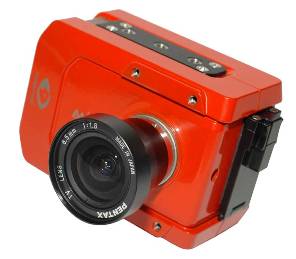|
||||||||||||||||||||||||||||||||||||||||||
|
||||||||||||||||||||||||||||||||||||||||||
| Phantom Miro Airborne Back to Phantom High Speed Cameras Back to Standard Resolution Monochrome Cameras Back to Standard Resolution Colour Cameras Back to High Speed Cameras |
 |
PHANTOM
MIRO AIRBORNE (monochrome or colour) CAMERA:
THE IDEAL SOLUTION FOR AIRBORNE APPLICATIONS
Easily managing uncontrollable and constantly changing lighting situations.
Combining the best features of the popular Phantom Miro 3 and Miro eX4, the Miro Airborne's compact, lightweight yet rugged form, in combination with its impressive balance of resolution, speed, non-volatile memory and light sensitivity, provides everything needed for successful high-speed digital imaging for airborne applications.
| WHAT
ARE THE KEY CHARACTERISTICS OF THE PHANTOM MIRO AIRBORNE CAMERA? |
|
| Light sensitivity | The CMOS active-pixel sensor's rating of 4800 (monochrome) 1200 (colour) ensures the light-sensitivity required in high-speed imaging. Access to all 12-bit grayscale information means that details in shadows resulting from uncontrollable and fluctuating lighting conditions, can be seen. |
| Easy playback | Play and rewind can be executed in normal or fast mode or the sequence can be stepped through, one frame at a time. |
| Easy edit | Trimming the movie is as easy as setting in-points and out-points prior to saving. |
| Blur elimination | Successful motion analysis is enhanced by operating with shutter speeds that range from 2usecs to 1/Frame Rate allowing objects to be frozen in motion |
| Flexibility | Fully controllable frame rates from 10fps to 1265fps full resolution and Continuously Adjustable Resolution (CAR) down to 32x8 pixels with higher frame rates. |
| Connections | Connect to a PC with 10/100 Ethernet for additional camera programming and control, and to retrieve test images in later analysis and processing. Connect to a standard analog video monitor (PAL or NTSC) for real-time monitoring of the camera image or for playback of images stored in the camera’s memory, providing an easy testing of camera readiness prior to filming. Camera live video can also be fed into the aircraft's telemetry system for ground station monitoring. |
| Memory | The Miro Airborne has two types of memory: 2GB (4 GB optional) volatile internal high-performance DRAM memory for high-speed capture; and a Type 1 removable CompactFlash™ card for storage, to which files can be copied and stored after triggering. |
| Lens mounts | 1" C-mount, C- to F-mount adapter for using F-mount lenses is included |
| Mounting options | Lens mounting holes provide anchorage for additional lens support and flange mount Hi-G and vibration-resistant lenses. Mounting plates on two sides of the camera provide plenty of options providing standard ¼-20 mounting holes. The plates are removable and replaceable with custom plates. |
| Hi-G capacity | Successful images can still be obtained at up to 40Gs of acceleration. All internal electrical components are conformally coated to protect against damp/humid environments |
| Flexible triggering | Images are taken according to preset options and the camera stores them in a circular buffer in internal memory. Should a setting be changed, the change can be viewed immediately on the built-in LCD or on an external monitor. The camera can also be set so that a trigger (from external hardware, an on-camera trigger button or software on a connected PC) starts the recording, stops the recording, or records a selectable number of frames before and after the trigger. An extra feature is the ability to set the camera to trigger on motion that occurs within the image. It also includes strobe out for light flash, Irig in, FSync for multi-camera synching and more. |
| Time referencing | Time stamping each image is possible via IRIG-B input giving a GPS-derived time reference for the camera if running asynchronous to IRIG timing. Frame synchronisation to GPS timing by phase-locking to IRIG allows synchronisation of the camera to a time standard or to other cameras without additional wiring. |
| Phantom software | Using the Phantom software provided, slow-motion movies can be saved in popular formats such as Quick Time or AVI, and frames saved as JPEG or TIFF images. If the camera is set up with the Phantom software, the settings will be retained even after power down enabling camera deployment untethered to the PC. |
| Model | Phantom Miro Airborne |
| Resolution | 800 x 600 - 8bit, 12bit |
| Sensor | CMOS | Video Output | Analog |
| Max. Frame Rate | 1265 fps (full resolution) to 111,100 fps (area of interest) |
| Memory | 2GB (4GB optional) |
| Mount Type | C-mount / F-mount (using adapter) |
| Operating Temp | -30°C to 50°C |
| Power Requirements | 12 - 30VDC, 12W |
| Dimensions | 11.4 cm x 6.6 cm x 8.1 cm |
| Weight | 0.9 kg |
|
If you like this page, please recommend and share it. |
|||
| More | |||



